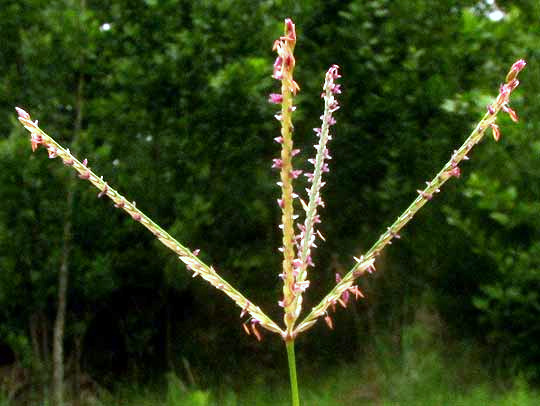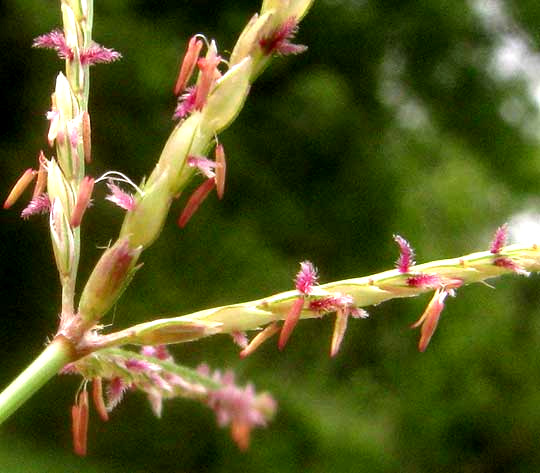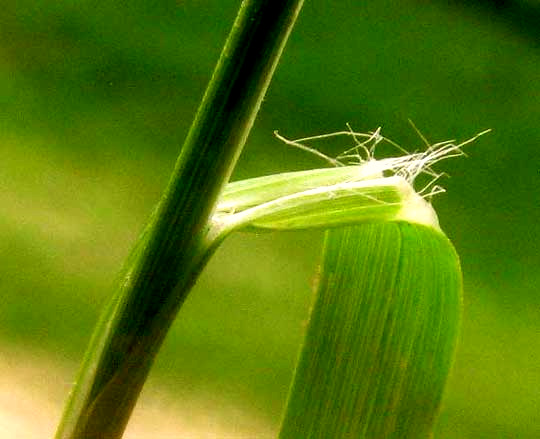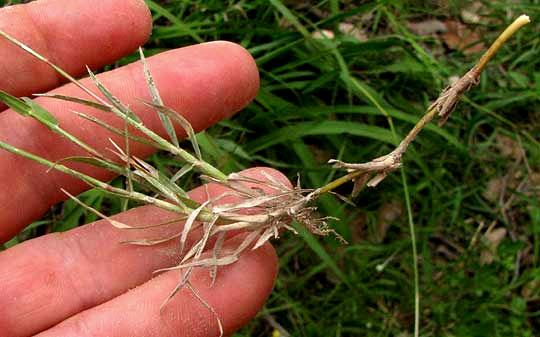Excerpts from Jim Conrad's
Naturalist Newsletter

from the June 22, 2014 Newsletter issued from the Frio Canyon Nature Education Center in the valley of the Dry Frio River in northern Uvalde County, southwestern Texas, on the southern border of the Edwards Plateau; elevation ~1750m (~5750 ft); N29.62°, W99.86°; USA
BERMUDA GRASS
Along an isolated part of the little one-lane gravel road running up the Dry Frio Valley a certain smallish, foot-tall grass was flowering, its heads of the kind with its branches spreading like toes on a turkey foot.That's it above.
North Americans are very familiar with grasses looking more or less, or exactly, like this, since both crabgrass and Bermuda Grass -- invasive weed-grasses in lawns and other much-disturbed areas -- produce flowering heads similar to these. So, which was this? Or was it something else entirely?

Above, a close-up of one of this grass's flowering heads, or inflorescences, shows an important field mark. That is, that the spike-like branches all arise together exactly at the tip top of the inflorescence stem, or peduncle. Bermuda Grass inflorescences do this, but usually -- but not always -- crabgrass' s don't. Crabgrass's spike-like inflorescence branches arise near one another atop the peduncle, but not exactly at the tip. You can see Crabrass's inflorescence at http://www.backyardnature.net/n/h/crabgrss.htm.
So that's a vote for Bermuda Grass, or something very close to it, but Crabgrass isn't completely eliminated yet.
A close-up of how the individual spikelets are arranged on just one side of the flattened, spike-like branches is shown below:

In that picture the flowers are at their sexual peak, the pale pinkish, oblong items dangling on slender, white filaments being the anthers releasing their pollen, while the fuzzy, dark, raspberry-colored things are stigmas of the female parts, reaching into the air for pollen.
Below you can see that this species' ligules -- the low, wall-like barrier where the leaf meets the stem, which may or may not be present, and which takes many forms -- is hairy:

Crab Grass's ligule is "membranous," which means that it's like a low, cellophane-like collar. It may or may not be hairy. However, the important point is that Bermuda Grass's ligule consists only of hairs. So at this point we can discard Crab Grass as a candidate.
Actually, we don't have to look for such a tiny detail to be convinced that we don't have Crab Grass, and you can see why below:

Our roadside grass's stems arise from a tough stolon -- in this picture the stolon being the stiff stem pointing toward the picture's top, right corner. Stolons can be thought of as stems that lie on the ground, often rooting at nodes where leaves may arise. Having such a stolon snaking across the ground, we see that our grass is a perennial. Crab Grasses are annuals with no such stolons.
So, this is indeed Bermuda Grass, CYNODON DACTYLON, native to the Middle East, not Bermuda, though it may have been introduced into the US from Bermuda where it arrived first. About five Cynodon species, all invasives, occur in North America, but Cynodon dactylon is by far the most common.
City folks with obsessions for monocultured, manicured lawns dislike Bermuda Grass because it is aggressive and can push neater-looking, gene-jangled turf cultivars aside. However, much of the world is grateful to Bermuda Grass because, at least in warm places, it makes good grazing for livestock where other grass species can't thrive. In California they've even shown that Bermuda Grass irrigated with salty water produces good forage for cattle. In fact, several Bermuda Grass cultivars have been produced providing humanity special services, and as global warming works its magic, in the future in certain areas Bermuda Grass may come to be regarded as a kind of savior.